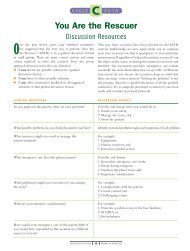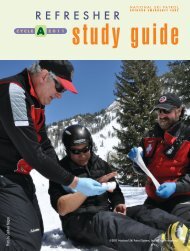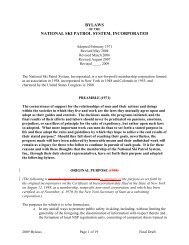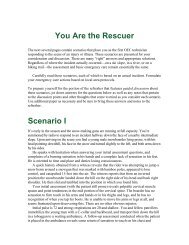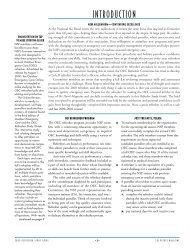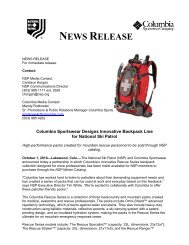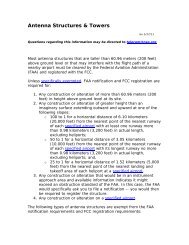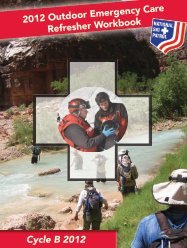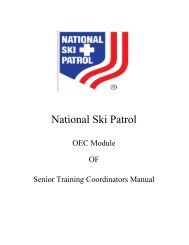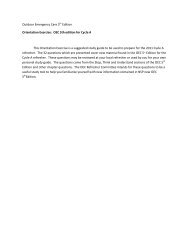Sierra Samaritans - National Ski Patrol
Sierra Samaritans - National Ski Patrol
Sierra Samaritans - National Ski Patrol
You also want an ePaper? Increase the reach of your titles
YUMPU automatically turns print PDFs into web optimized ePapers that Google loves.
❚ CONTINUED FROM PAGE 63<br />
❚ Each proximal wrap moves further<br />
up the limb, and each distal wrap<br />
reinforces it.<br />
As you progress, you will note that the<br />
bandage forms an elegant interlocking<br />
pattern. Be sure that every wrap angles<br />
either proximal or distal. If some wraps go<br />
straight across and around the limb, the<br />
bandage will be irregular and less secure.<br />
figure 2<br />
Figure Eight Wrap<br />
ILLUSTRATIONS BY EVELYN SINCLAIR<br />
Finger Bandages<br />
Be sure to remove any rings, watches, or<br />
bracelets before applying a finger or hand<br />
bandage (and preferably before swelling<br />
makes removal difficult). Then put them<br />
with the other personal property that will<br />
go with the patient to the hospital.<br />
To make sure a finger bandage stays<br />
on, always anchor it to the wrist and go<br />
across the back of the hand when running<br />
the wrap from the wrist to the finger<br />
(fig. 3). This method has two advantages:<br />
It ensures that flexing the hand will tighten<br />
(not loosen) the bandage, and it keeps the<br />
bandage out of the way in case the patient<br />
has to use the hand. The direction in<br />
which you wrap the wrist depends on<br />
which finger you are bandaging because<br />
you should go diagonally across the hand<br />
to the finger, not straight up, to keep the<br />
wrist anchor secure. So, for a bandage of<br />
the ring or little finger, cross the back of<br />
the hand from the radial to the ulnar side<br />
of the wrist, and for a bandage of the<br />
thumb, index, or middle finger, cross from<br />
the ulnar to the radial side.<br />
❚ Apply a dressing to the wound and<br />
ask the patient to hold it with the<br />
adjacent finger.<br />
❚ Anchor the bandage at the wrist,<br />
leaving one corner out then folding it<br />
over and locking it down with a subsequent<br />
wrap around the wrist.<br />
❚ Unroll the bandage to the base of the<br />
finger, ask the patient to fan out the<br />
fingers while you hold the dressing to<br />
the injury, then secure the dressing<br />
with a spiral wrap, moving up toward<br />
the tip of the finger.<br />
❚<br />
❚<br />
❚<br />
❚<br />
❚<br />
From the finger tip, spiral back to the<br />
base of the finger.<br />
If you need to cover the finger tip,<br />
do some up and down wraps from<br />
the base over the finger tip and back<br />
to the base.<br />
Secure the up and down wraps with<br />
more spiral wraps.<br />
From the base of the finger extend<br />
the bandage back to the wrist, this<br />
time stretching the bandage to the<br />
opposite side than you started on,<br />
and secure it with a bow or knot.<br />
You can bandage several adjacent<br />
fingers with the same gauze roller,<br />
provided the dressings separate the<br />
injured fingers.<br />
Hand Bandages<br />
A hand bandage, like a finger bandage,<br />
should be both started and finished at the<br />
wrist (fig. 4.) This will anchor it securely,<br />
while allowing the patient to use the hand<br />
if necessary, e.g., in a self-evacuation from<br />
the wilderness. The figure-eight wrap with<br />
a gauze roller works for holding a dressing<br />
on either the palm or the back of the hand.<br />
❚ After anchoring the bandage at the<br />
wrist, wrap alternately around the<br />
distal and proximal side of the<br />
thumb, overlapping to cover most<br />
of the dressing.<br />
❚ Fold the end or corner of the dressing<br />
over and lock it down with the<br />
next wrap.<br />
64 <strong>Ski</strong> <strong>Patrol</strong> Magazine | Winter 2005






